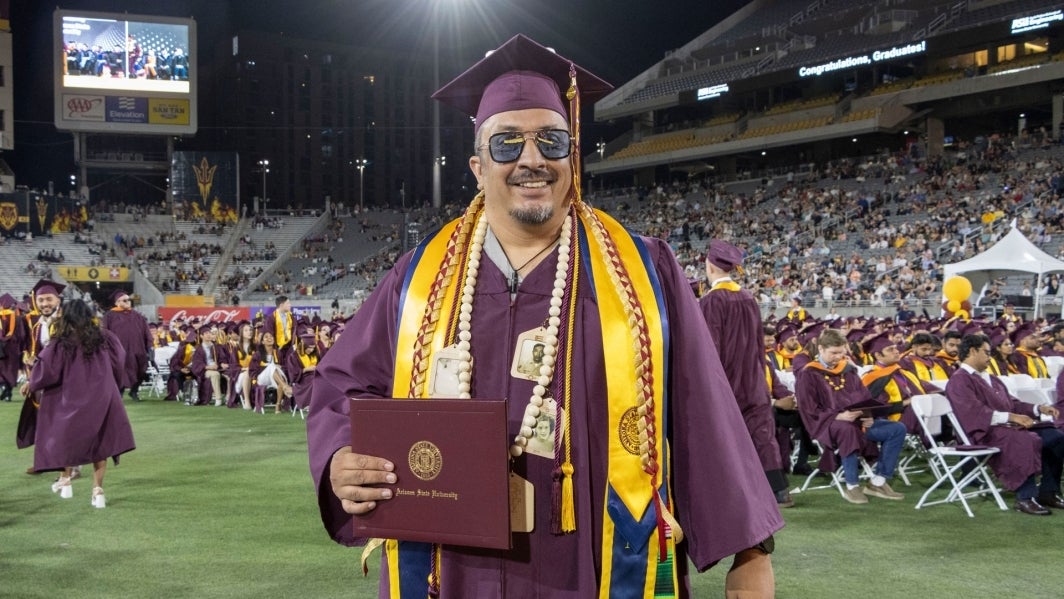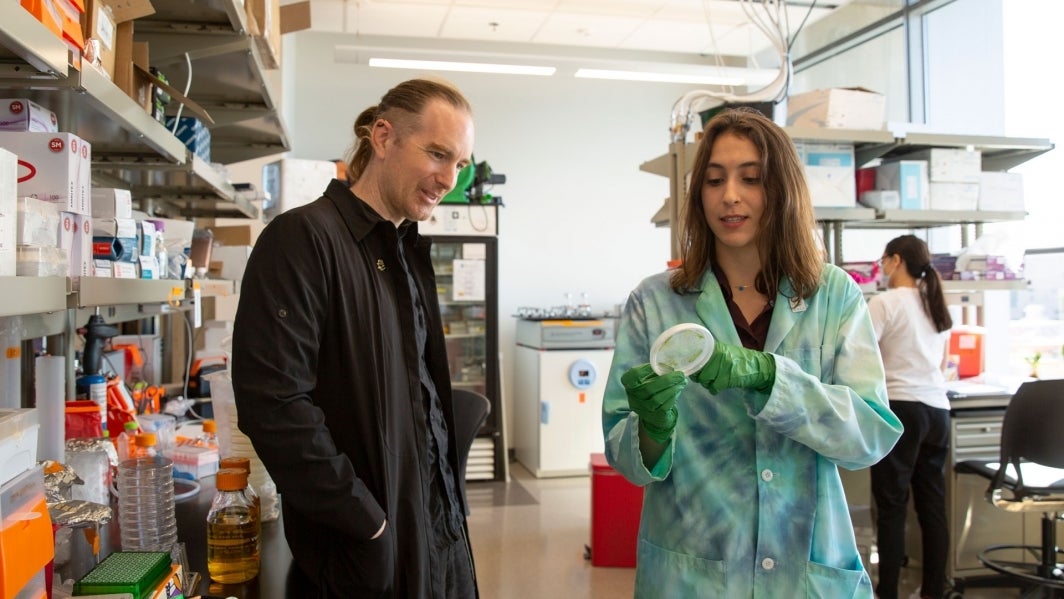Inclusive ASU engineering community nurtures success

(From left) Louis Moon, Michael D’Saachs and Ashley Tse, biomedical engineering students in the Ira A. Fulton Schools of Engineering at Arizona State University, pose at the ASU Open Door outreach event. As leaders of the Biomedical Engineering Society chapter at ASU during the 2022–23 academic year, these students planned events and opportunities to make the student organization an inclusive community to help biomedical engineering students thrive. Photo by Monique Clement/ASU
The popular image of the lone genius scientist and engineer means many people are unaware that engineering actually relies on teams working together. For Michael D’Saachs, a biomedical engineering graduate student in the Ira A. Fulton Schools of Engineering at Arizona State University, the social side of engineering has been his focus since he came to ASU.
“Engineering itself is a team sport,” D’Saachs says. “You’re hardly ever doing anything on your own. Even in industry you’re not going to solve an engineering problem by yourself; it’s going to be a team of engineers doing it.”
D’Saachs and other students in the Fulton Schools have many opportunities to seek out welcoming communities while expanding their engineering skills. One of these ways is through student organizations such as the Biomedical Engineering Society chapter at ASU, known as BMES.
The organization regularly holds group events such as general student body meetings with guest speakers representing a diverse range of clinical, research and industry positions. BMES also hosts social, entrepreneurship, high school outreach and professional development events.
“I believe the students who engage with our organization are more connected with other students in the classroom and can leverage what they have learned with BMES to become leaders inside and outside of the classroom and make informed choices for their future success,” says Ashley Tse, president of BMES during the 2022–23 academic year.
Two leadership board members who contributed to engagement efforts last year were D’Saachs, former peer engagement director of BMES, and Louis Moon, former mentorship director of BMES. Together with the rest of the leadership team, they helped foster a collaborative community of engineers and supported student success.
Bringing people together
As a nontraditional student going back to school during the COVID-19 pandemic, D’Saachs’ college life started as a very isolating experience. He says people didn’t often engage with him during his time at community college, perhaps because he was an older student and different from his peers.
“That changed when I came to ASU,” says D’Saachs, who graduated in May 2023 with a bachelor’s degree in biomedical engineering from the Fulton Schools and is returning this fall to finish his master’s degree as part of ASU's accelerated master's in biomedical engineering degree program.
At ASU, he joined BMES and the Society of Hispanic Professional Engineers. D’Saachs enjoyed the social aspects of BMES so much that when the opportunity arose to apply for the peer engagement director position, he decided to run for it.
D’Saachs drew upon his experience in community college getting his associate degree, his time in the military leading team-building exercises and his role as a parent encouraging his two sons to get involved in social activities to help him rebuild the organization's in-person offerings as the pandemic eased.
He hosted board game nights, ice cream socials, pick-up volleyball and even put together a medical imaging art class with Benjamin Bartelle, an assistant professor of biomedical engineering in the Fulton Schools. However, events like these are more than just fun and games, D'Saachs says.
He believes introducing students to each other early in their academic careers is important to improving the capstone project experience. The yearlong capstone project at ASU involves four or five seniors devising a solution to an engineering problem, applying all the skills they’ve learned throughout their degree programs.
To accomplish this, he created an event called Capstone and Coffee, where first-year and sophomore students could meet their peers and the capstone professors in an informal setting to learn more about this critical component of their major.
“My hope is that by bringing students together, they can engage and express what it is about biomedical engineering that they enjoy, and try to foster those relationships within biomedical engineering,” D’Saachs says. “That gets them in a spot where they feel more comfortable down the road doing capstone.”
Mentoring students for success
Engaging with junior and senior students in the major is also an opportunity for first-year and sophomore students to learn more about the possibilities in biomedical engineering.
Led by biomedical engineering junior Louis Moon in the 2022–23 academic year, the BMES mentorship program is another community-building opportunity students can participate in.
“I think mentorship is important because it’s almost impossible to know what you’re getting into when you start your degree,” Moon says. “It’s great to have someone who has gone through your academic path give you some guidance or an idea of that path.”
Just as D’Saachs was challenged with rebuilding a sense of community coming out of the pandemic, Moon also worked to bring students together again with in-person mentorship program meetings alongside virtual ones.
He also added a new lab shadowing component to the mentorship program. This opportunity breaks down time and access barriers to allow students to learn what it's like to work in a research lab from their peers and see experiments in action.
Building bigger and better communities in the new academic year
Under Naina Misra, a biomedical engineering junior who serves as the student organization’s president for the 2023–24 academic year, the BMES leadership team plans to continue expanding what the organization offers Fulton Schools students.
Camryn Sheen, a biomedical engineering sophomore taking over the peer engagement director role this year, says BMES members can look forward to more of the engagement events D’Saachs helped develop, such as game nights and art activities with Bartelle. Sheen also plans to create new events to support peer engagement, such as biomedical engineering trivia nights and viewing parties for documentaries related to the major, such as "The Bleeding Edge."
Cameron Knight, a biomedical engineering sophomore and the new mentorship director, continues to expand upon activities like lab shadowing, which was a big success, and wants to enable more students to take part.
Knight also plans to start a journal-sharing activity in which postgraduates share their biomedical engineering journeys to help current students understand how they can use their degrees after graduation.
Misra notes other exciting events and opportunities in the works for the year, including helping undergraduate students learn about advanced degree and research pathways from current graduate students and other opportunities for all students to learn about entrepreneurship and founding new ventures in Arizona. She says BMES is also planning tours at biomedical research organizations such as Medtronic and the Translational Genomics Research Institute, or TGen, and forming a new Biomedical Engineering Design Team to compete in the Medtronic/BMES Student Design Competition at the national BMES Annual Meeting in 2024.
Misra, Sheen and Knight encourage all biomedical engineering students to join BMES, where they can find new friends and opportunities to network and be welcomed into a supportive, fun community.
“BMES is an organization that values community, inclusivity and involvement,” Misra says. “It is an amazing way for biomedical engineering students to learn about their field, discover their interests and gain an idea of their future impact. BMES was built by those interested in biomedical engineering for those interested in biomedical engineering, and I encourage everyone who wants to learn more and become involved to join.”
Interested in joining the Biomedical Engineering Society chapter at ASU? Sign up for the BMES mailing list for more information, follow them on Instagram at @bmes.asu for the latest updates, and find more ways to get involved on the organization’s Linktree.
More Science and technology

ASU professor wins NIH Director’s New Innovator Award for research linking gene function to brain structure
Life experiences alter us in many ways, including how we act and our mental and physical health. What we go through can even…

ASU postdoctoral researcher leads initiative to support graduate student mental health
Olivia Davis had firsthand experience with anxiety and OCD before she entered grad school. Then, during the pandemic and as a…

ASU graduate student researching interplay between family dynamics, ADHD
The symptoms of attention deficit hyperactivity disorder (ADHD) — which include daydreaming, making careless mistakes or taking…


